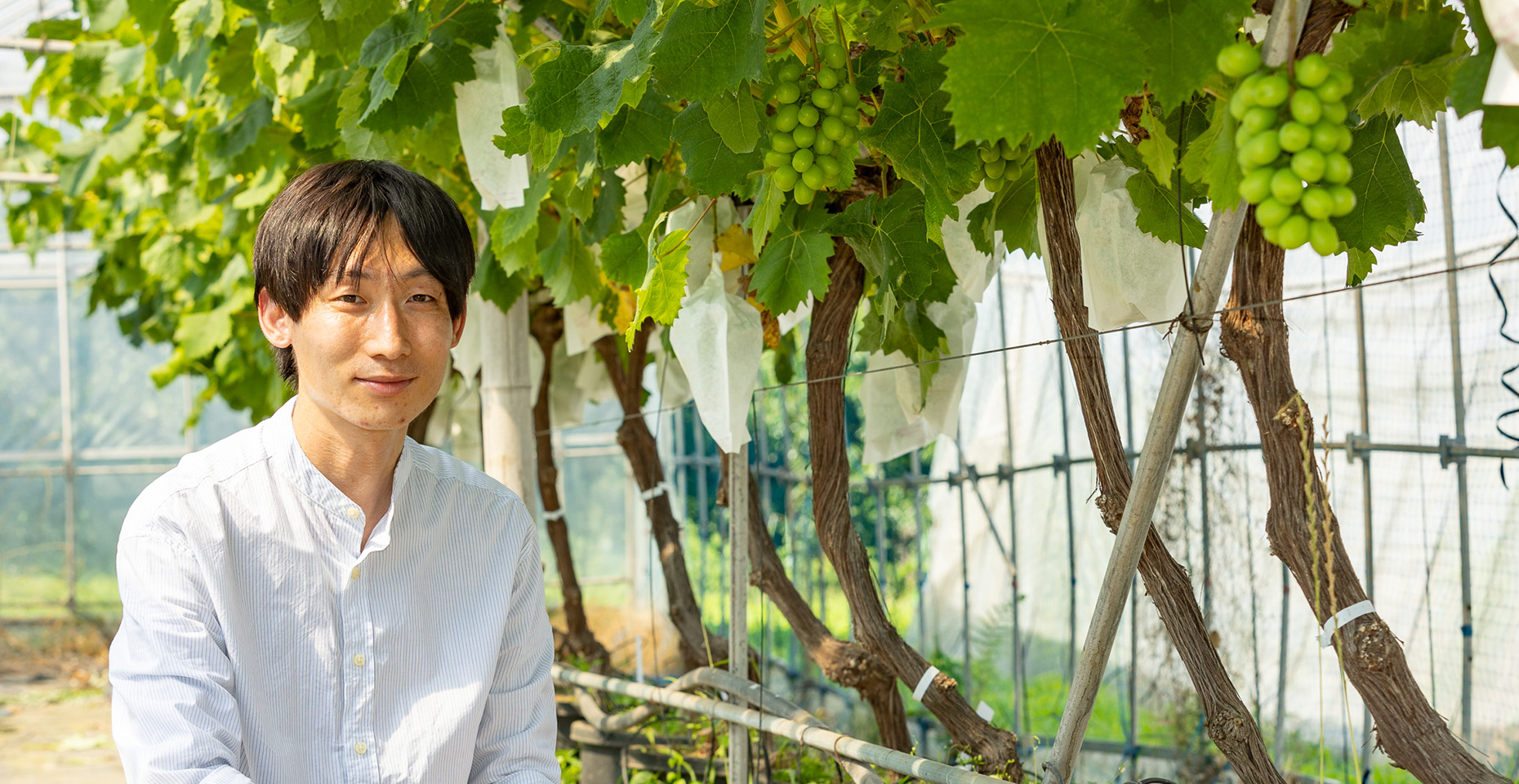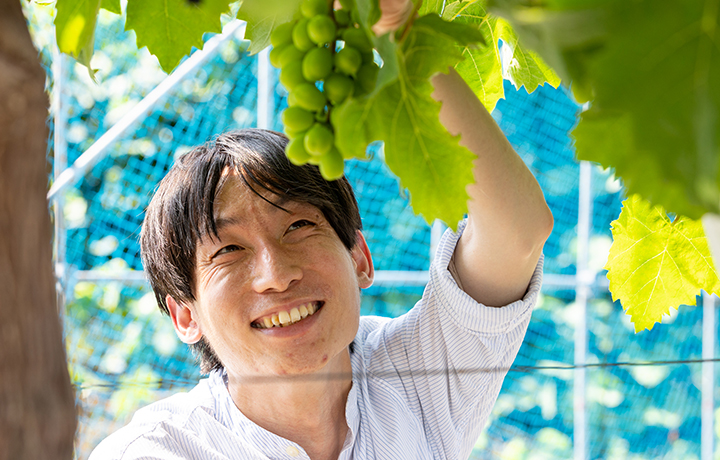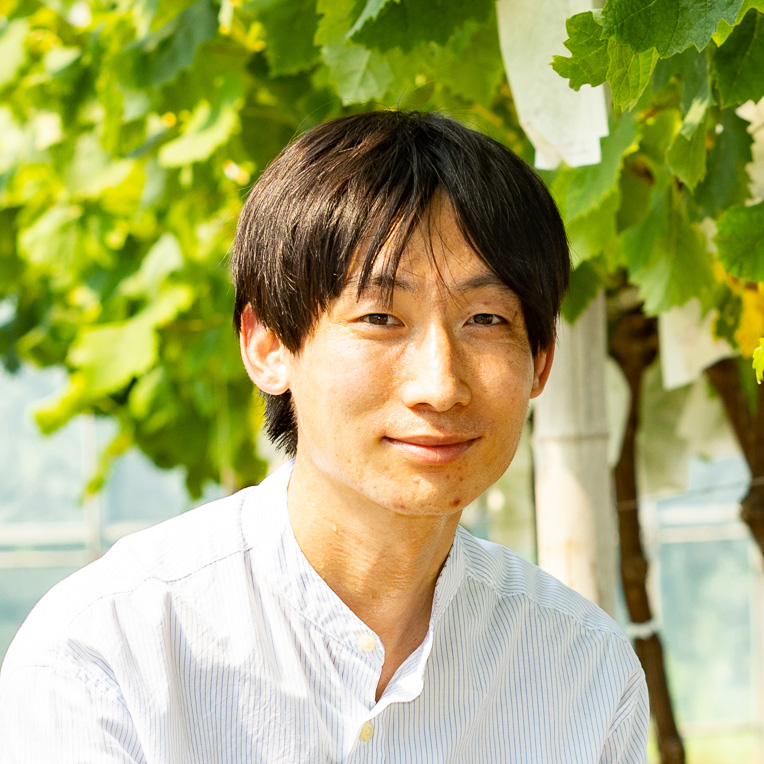Buds sprout, and flowers boom; fruits ripen, and leaves fall. This annual routine, the life cycle of a fruit tree, is embedded and passed down in its genetic code. We interviewed Assistant Professor Takanori Saito of the Graduate School of Horticulture—who is exploring and applying the still enigmatic phenology of fruit trees at the genetic level and endeavoring to cultivate even more attractive fruits—regarding the challenges facing fruit cultivation and their potential solutions.
The autumn chill is the signal to turn the alarm ON
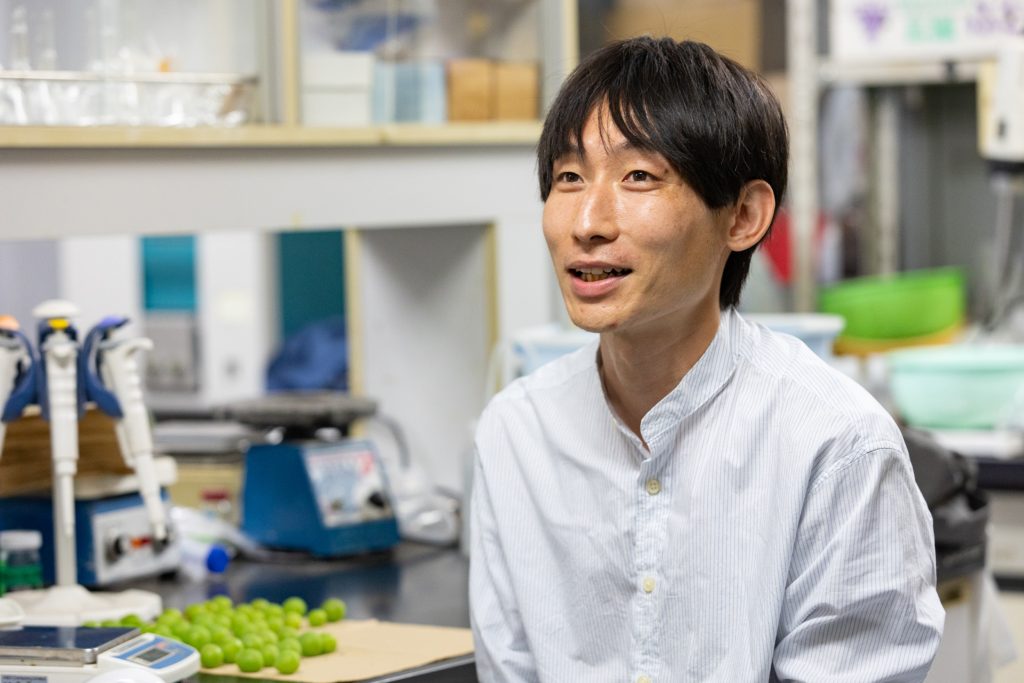
—I heard that cold weather is necessary for cherry blossoms to bloom, but why would the cold be necessary?
Though plants cannot move from the place where they sprout, they have various sensors that are sensitive to environmental changes. The seasonal changes to the state of the plant constitute its phenology. For example, fruit trees in temperate zones have a mechanism to switch on dormancy (or growth cessation) when the day length get shorter and cooler in autumn and winter. It is like setting the alarm before getting to bed.
Then, after spending some time in a chilled environment, the alarm goes off and awakens the plant from its dormancy. The chilling requirement differs from one plant to another. For example, apples go dormant around autumn, requiring more than two months of cold. This time is known as the chill hours. Grapes do not require as many chill hours, with some varieties requiring less than a full month.
By the way, you may have an impression that cherry blossoms bloom when it gets warm. While this is true, there is more to the story. Even though the alarm may go off after satisfying the chilling requirement, the switch to bloom does not kick in if it does not get warm enough. It is just like us on a cold morning, unable to get out of bed though the alarm has already gone off. Parenthetically, the reason the Yoshino cherry variety—the most representative cherry variety of Japan known, also known as Somei-Yoshino—does not bloom in Okinawa is because the environment does not offer the required chilling period.
Unraveling the Mystery of How Fruits Have Adapted to Their Environment
—How do plants know the changes in seasons in the first place?
Plants have adapted to their environment over the ages. Plants have survived by incorporating and embedding environmental data into their DNA to act as their unique calendar and have passed this on to the next generation.
―Do plants grow exactly as they are coded in their DNA?
No, it does not mean they grow 100% in accordance with their genetic information. Just as identical twins who share the exact same genetic information have their own personalities, the environment and other external conditions can induce various changes in plants.
One such research is on the study of apple pigmentation, conducted by a group of researchers from Chiba University, Shizuoka Professional University of Agriculture, and Hirosaki University. Mutsu is a variety of an apple commonly known as the green apple, as its skin is yellow-green. It was thought that its yellow-green color was due to the lack of anthocyanin, the pigment responsible for the red color in fruits. However, as shown below, this apple has a mysterious property: when the light environment changes, its skin turns red.
The fruit is covered with paper bags when it is young to protect it from wind, rain, and insects. We grew Mutsu by covering the fruit with paper bags in three different patterns.
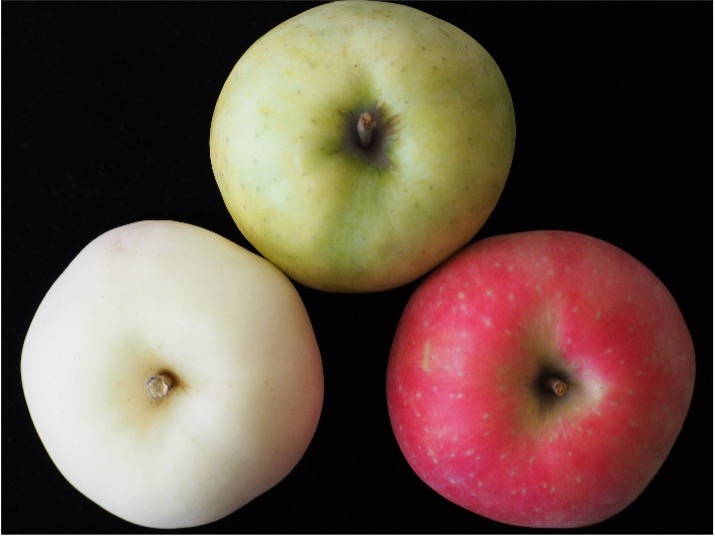
(1) Cultivated with a paper bag covering: white skin (Photo on the left)
(2) Cultivated without a paper bag covering: yellow-green skin (Photo in the center)
(3) Cultivated with the paper bag covering removed mid-way through its growth phase: red skin (Photo on the right)
This experiment proved that the characteristics of fruit could be changed just by changing its growing environment without any genetic modification. This is assumed to be due to stress responses (e.g., methylation of cytosine) by the plant.
Environmental adjustment and genome editing: In 2021, a project was launched to apply these two methods to create new fruit varieties with greatly improved color, sweetness, and aroma, which would offer a higher market value. The research is primarily focused on grapes, with the aim of releasing a Chiba University-labeled wine around 2030.
Celebrating anniversaries with one-of-a-kind, custom-made wine
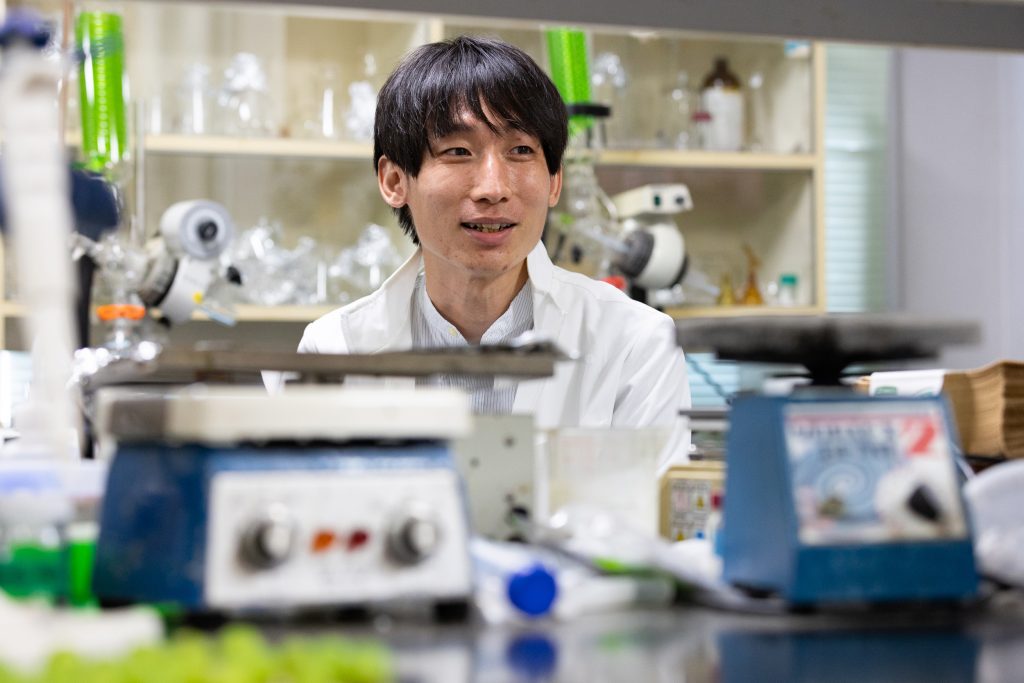
―In 2021, your research project, “Establishment of Advanced Fruit Tree Cultivation Technology for Grape Cultivation in Plant Factories,” was selected as a Frontier Research Project in Horticulture from the Graduate School of Horticulture. What kind of research is meant by “advanced fruit tree cultivation”?
Without taking care of fruit trees, including grapes, branches or vines will grow out of control and in every which way. Their complex structures make automated operations and mechanized harvesting difficult.
Additionally, the timing of the harvest is quite important to making delicious grapes. If they are harvested too early, they become sour due to a lack of sugar, and if harvested too late, the flavor profile lacks balance. In recent years, due to global warming and abnormal weather conditions, it has become difficult to determine the optimal time to harvest. Furthermore, harvesting is quite a difficult task, especially as it occurs around the typhoon season; it is also a challenge to prevent the fruit from getting damaged by rain or typhoons.
To solve this problem, in our Project, we started to develop new grape cultivation techniques and new varieties of grapes that are easy to harvest with automated machinery by simplifying and downsizing the complex structures. We call them “designer berries” as they are precisely designed grapes.
We are also conducting research to enhance the taste and aroma of our wines at the same time. We want to make it possible to create one-of-a-kind custom-made wines that not only have a wonderful taste, but also tell a story, such as an original wine inspired by someone special.
―Why did you focus on grapes?
The history of viticulture and wine production dates back to ancient Egypt, and there is no exaggeration to say that it epitomizes European civilization. Wine has been a favorite of Europeans for thousands of years, but recent climate change has made the cultivation of quality grapes more difficult in France, and it is predicted that the most suitable regions to grow grapes will shift northward.
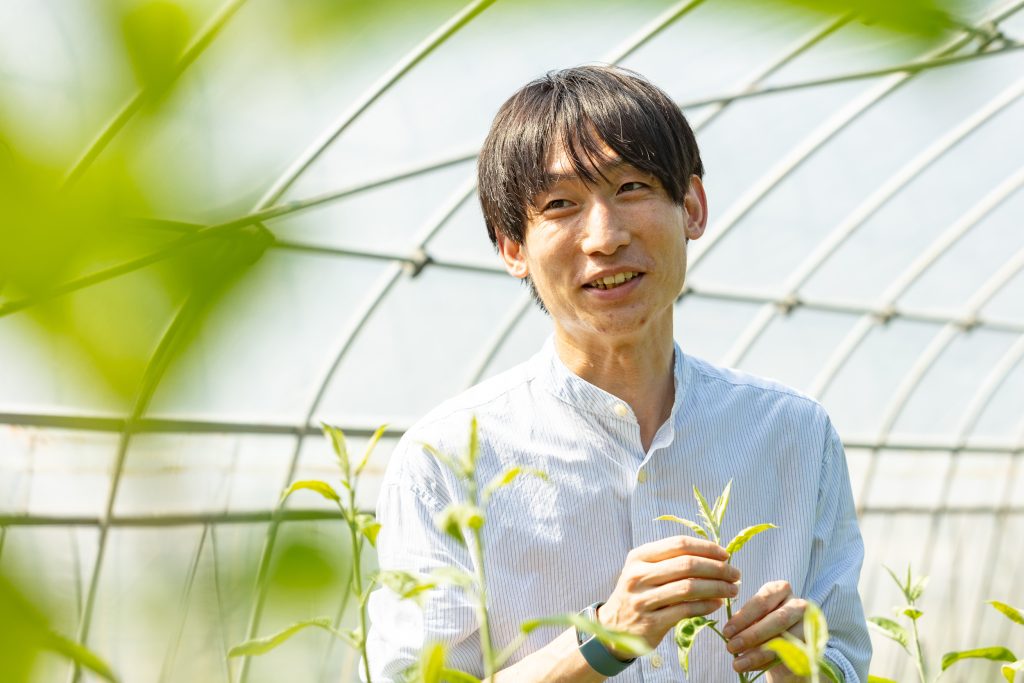
―You are implying here that the effects of climate change are threatening thousands of years of culture passed down through the generations.
Japan is no exception. Global warming is causing problems, such as poor pigmentations in grapes during summer due to high temperatures. Japanese pear blossoms are not flowering due to insufficient length of chill hours during the winter. The same problems are expected to occur in the future for various fruit trees as global warming progresses.
Although achieving immediate results is difficult, our research aims not only to solve the global-scale social problems caused by global warming, but also to contribute to Japan’s fruit industry. Currently, we are researching genes that improve pigmentation even in warm weather with the goal of improving varieties. Additionally, we are using culture techniques to search for medicines that can induce flowers to bloom even in insufficiently cold weather.
Furthermore, we have set a goal to grow compact-sized grapes and cultivate them in plant factories. Plant factories are unaffected by climate change and can grow plants anywhere in the world. It is no longer a mere dream to think of making wine from grapes grown in Antarctica or space.
―How far has this research progressed?
We are currently examining new training systems to miniaturize the grapevine size. The harvest will finally begin next year. However, there are drawbacks to miniaturization; namely, the amount of fruit produced will inevitably be reduced. We are searching for the optimum growing conditions that can achieve both the ideal fruit size and compactness of the vines using 3D data, monitoring, and other cutting-edge technologies.
We are also experimenting with ways to utilize the fruit. We began experimenting with artificially changing climatic conditions and storage techniques to produce sweet dessert wines.
―Do you collaborate with professors from other labs?
This project is a product of a collaboration between seven professors from the Graduate School of Horticulture, including Associate Professor Akira Kato of the Tree Design Team; Associate Professor Shoko Hikosaka of the Fruit Design Team; and Professor Hiroaki Kodama of the Genome Design Team. This project is unique to the Faculty of Horticulture of Chiba University and has been enriched with insights and wisdom from all these professors—so, it feels a little presumptuous to assert that I am the leader. Our goal is to develop a Chiba University brand of wine through a variety of experiments.
I will strive for the success of the project so that we can honor the collaborative efforts of the professors and give shape to the dreams shared by us all.
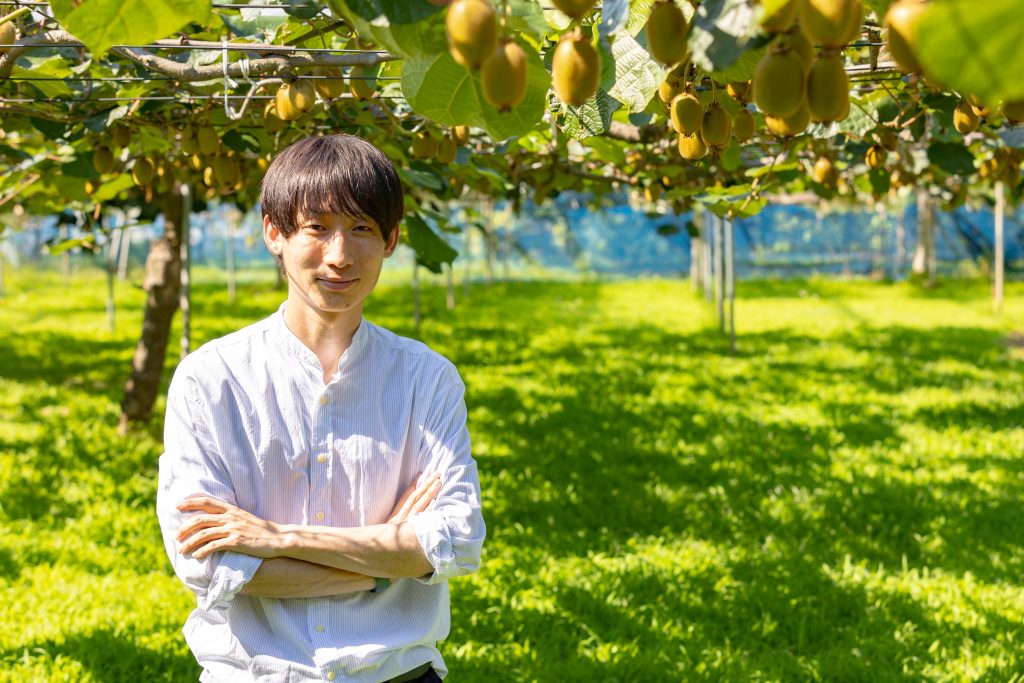
Series
Horticulture Innovation −Creating the Future of "Food" and "Greenery"−
Chiba University is the only national university that accommodates a department of horticulture in Japan. We highlight our researchers who are exploring the possibilities of Food and Landscape.
-
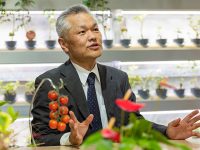
#1
2022.09.27
Fostering Global Well-being Through Horticultural Innovation
-
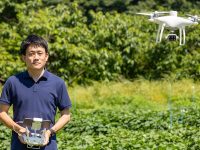
#2
2022.10.17
Making the Invisible Visible: Drones Enabling Agricultural Advances
-
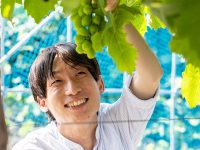
#3
2022.11.07
Designing a world-class climate-resistant fruit!~Developing “Designed Grapes” for Custom-Made Wine to Commemorate Special Occasions
-
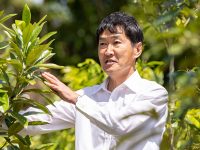
#4
2023.02.02
Towards a self-sustainable natural environment: The science of restoration ecology, where researchers engage in conversation with the earth
-
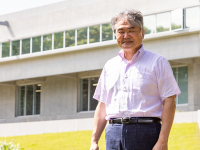
#5
2023.05.19
The reciprocity of life: The interactive relationships between people, plants, and the environment
Recommend
-

Decoding the Secrets in Art: The Art and Legacy of Early Modern European Female Painters
2024.07.24
-
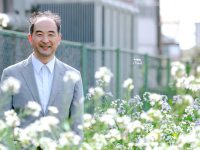
Viewing a Diverse World through the Lens of Agriculture and Food: Enriching Global SDGs Education with Insights from Extensive Overseas Field Research
2023.08.31
-
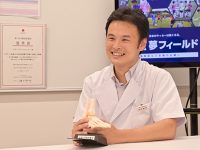
A Day in the Life of a Sports DoctorProfessionals behind the world’s most prominent sporting events
2023.04.13


